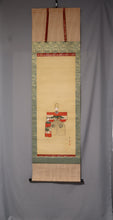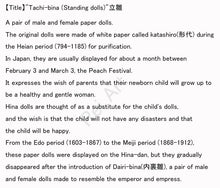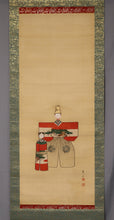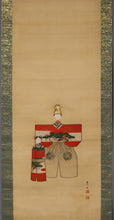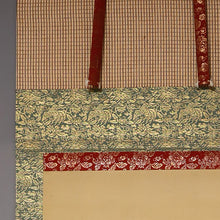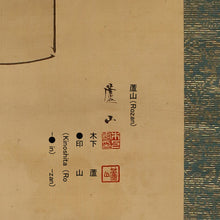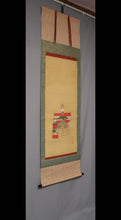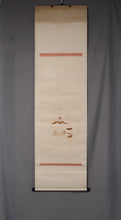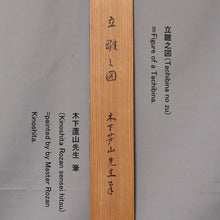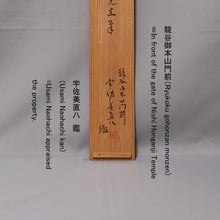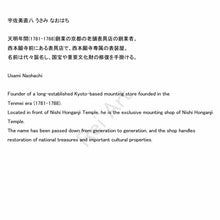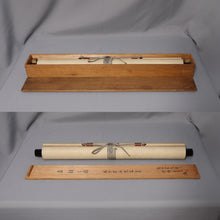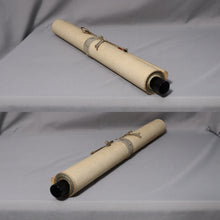
For all customers
※Products that use ivory will be changed to other materials and shipped.
This is because the Washington Convention currently prohibits the export and import of ivory products in all countries including Japan.
※you may be charged Value Added Tax (VAT) by the state when you receive your purchased artwork.
(Amount according to the laws of each country.Nearly 20%-30% of the purchase price and shipping costs)
Art work details
Setting weight
This piece weighs 0.9 kg and will be shipped in 80 size.
Material
Japanese pigments on silk
Size
Overall: vertical 180 × width 50.2 cm*width does not include roller ends.
(the work: vertical 101.4 × width 39.8cm)
Condition
・There are burns, stains, wrinkles, floats on the Japanese paper on the back of the cover.
・There are some burns, stains, wrinkles on the image.
・There is a slight peeling of white pigment.
・There are some burns, wrinkles, warp in mounting.
Remarks
Roller ends is lacquerware.
・Usami Naohachi appraised the piece and signed the box.
Materials for mounting
・All of them are made of silk.
Other
**There is a note about shipping restrictions and VAT. Please check before purchase.**
*There may be a slight difference in color between the photo and the actual product.
Biography
Kinoshita Rozan (?-?)
・The bio of the author is unknown.
A word from the store
This is a painting of Hina dolls displayed during the Japanese Peach Festival on March 3.
Unlike modern Hina dolls, the model in the painting is an early Hina doll called Tachibina.
The margins of the painting have some foxing, stains, wrinkles, etc. due to its age.
The white paint on the face also has some peeling.
However, the other colors retain the good coloring of the old pigments.
The mounting is made of gorgeous, high-quality silk, as befits a festive occasion.
From the inside, there are camellia, phoenix, and lattice patterns.
It is likely that Usami Naohachi, the mounting artist who appraised this work, did the work.
Therefore, even decades after it was mounted, the rest of the surface remains in good condition with only some fraying of the threads.
No details of the artist, Kinoshita Rozan, were found in the literature.
From the name, it seems that he was related to the Osaka painter Kinoshita Roshu(1807-1879).
Main Meaning
"Tachi-bina (Standing dolls)"
A pair of male and female paper dolls. The original dolls were made of white paper called katashiro(形代) during the Heian period (794-1185) for purification. In Japan, they are usually displayed for about a month between February 3 and March 3, the Peach Festival. It expresses the wish of parents that their newborn child will grow up to be a healthy and gentle woman. Hina dolls are thought of as a substitute for the child's dolls, and the wish is that the child will not have any disasters and that the child will be happy. From the Edo period (1603-1867) to the Meiji period (1868-1912), these paper dolls were displayed on the Hina-dan, but they gradually disappeared after the introduction of Dairi-bina(内裏雛), a pair of male and female dolls made to resemble the emperor and empress.
Precautions
[Important Notice]
Please pay attention to the following points before buying.
●We will ship from Japan to the rest of the world.
As a result, you may be charged Value Added Tax (VAT)
by the state when you receive your purchased artwork.
(Amount according to the laws of each country.
Nearly 20%-30% of the purchase price and shipping costs)
●In addition, please note that we are not able to "under-value" the purchase price at the time of shipping.
●※Recently, there has been an increase in the number of cases
where packages have not been delivered to Italy.
For Italian customers, we may ask for "codice fiscale" after
purchase. Please be forewarned.
●Currently, the Washington Convention prohibits the export and import of ivory products in all countries including Japan. If ivory is used as the material in the hanging scroll / Bokuseki work, we will change it to another material and ship it.
Thank you for your understanding in advance.
About shipping
The standard shipping fee is as follows.
Currency unit is Japanese Yen.
If you have any questions, please contact us.
EMS
| EMS | |||||
|---|---|---|---|---|---|
| Maximum weight | Area | ||||
| A | B | C | D | E | |
| Asia | Asia2 | Europe, Oceania, Middle East, North Americ | North America | Africa | |
| 0.5kg | ¥1,450 | ¥1,900 | ¥3,150 | ¥3,900 | ¥3,600 |
| 0.6kg | ¥1,600 | ¥2,150 | ¥3,400 | ¥4,180 | ¥3,900 |
| 0.7kg | ¥1,750 | ¥2,400 | ¥3,650 | ¥4,460 | ¥4,200 |
| 0,8kg | ¥1,900 | ¥2,650 | ¥3,900 | ¥4,740 | ¥4,500 |
| 0.9kg | ¥2,050 | ¥2,900 | ¥4,150 | ¥5,020 | ¥4,800 |
| 1.0kg | ¥2,200 | ¥3,150 | ¥4,400 | ¥5,300 | ¥5,100 |
| 1.25kg | ¥2,500 | ¥3,500 | ¥5,000 | ¥5,990 | ¥5,850 |
| 1.5kg | ¥2,800 | ¥3,850 | ¥5,550 | ¥6,600 | ¥6,600 |
| 1.75kg | ¥3,100 | ¥4,200 | ¥6,150 | ¥7,290 | ¥7,350 |
| 2.0kg | ¥3,400 | ¥4,550 | ¥6,700 | ¥7,900 | ¥8,100 |
| 2.5kg | ¥3,900 | ¥5,150 | ¥7,750 | ¥9,100 | ¥9,600 |
| 3.0kg | ¥4,400 | ¥5,750 | ¥8,800 | ¥10,300 | ¥11,100 |
| 3.5kg | ¥4,900 | ¥6,350 | ¥9,850 | ¥11,500 | ¥12,600 |
| 4.0kg | ¥5,400 | ¥6,950 | ¥10,900 | ¥12,700 | ¥14,100 |
| 4.5kg | ¥5,900 | ¥7,550 | ¥11,950 | ¥13,900 | ¥15,600 |
| 5.0kg | ¥6,400 | ¥8,150 | ¥13,000 | ¥15,100 | ¥17,100 |
Country classification
A: Asia
China, South Korea, Taiwan
B : Asia
Hong Kong, Macau, Singapore, Thailand, Philippines, Vietnam, Malaysia
C : Europe, Oceania, Middle East, North America
Austria, Belgium, Bulgaria, Croatia, Czech Republic, Denmark, Estonia, Finland, France,
Germany, Hungary, Iceland, Ireland, Italy, Latvia, Lithuania, Luxembourg, Netherlands, Norway, Poland,
Portugal, Slovenia, Spain, Sweden, Switzerland, the United Kingdom, Australia, Canada, Mexico, New Zealand,
Romania, Greece
D : North America
United States of America
E : Africa
South Africa












